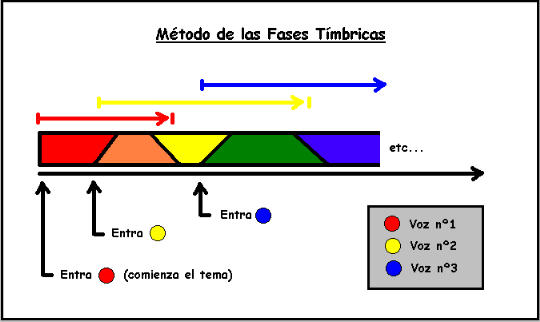Fases
Tímbricas (Sound Phases)
Till now I have composed two
themes based in Sound Phases method. Here you have a
sample of each one:
Fases
Tímbricas I (Sample) - fti1.mp3 - 223 Kb
Fases
Tímbricas II (Sample) - fti2.mp3 - 307 Kb
Sound Phases
Method.
Sound Phases Method is based in a gradual
change of sound. This is a method which needs lots of
sounds and the resulting music is difficult to play.
So if you compose for a real group, you will need
many musicians and it will spend a great amount of
time in rehearsing the music.
The synthesizer resolves these problems. It offers
lots of sounds for use in a composition, and you can
controle the whole theme through the sequencer. You
can say that The Method of Change of Sound
is specially created for composition which will be
played on synths. This doesn't mean that this music
can't be played by any kind of musical group.
First of all you compose a melodic and rhythm
pattern that is repeated along the whole theme. There
are no changes in melony nor rythm, so you needs to
change other element of the piece. This element is
the sounds, the instruments. As the composition is
evolving different instrumental lines are slowly
added and retired. This produces a gradual change of
sound in the piece.
Let's see a single example in order to understand
this method. Imagine a repetitive pattern of five
notes played on flute. Then a piano enters the
composition making a crescendo from the
silence. Piano and flute are playing the same melody
so a change of sound has been produced. But the
pattern is the same, the five notes have not suffered
a change. After some repetitions the flute makes a diminuendo
to the silence, so the pattern is played by a solo
piano. The sound has changed again.

The pieces constructed using this method are based
in variation of sound, so the variation comes from
the number of sounds used in these compositions and
the number of combinations resulting of mixing the
sounds used. But it doesn't mean that you can not use
other variation methods in the music, as the Combination
Method explained above, o the methods developed
by the great minimal composer in their composition
(the additive method, cyclic structures, phase
patterns...) or any other kind of method.
Accents Method
One of the variation methods I have applied onto
the pieces written using the method of change of
sounds is the Accents Method, which consists
in taking a rhythm pattern and accentuate one of the
notes of the pattern. After some repetitions I
accentuate other note of the pattern, so it sounds
now different. It seems like little invisible
melodies come up from the composition. If the pattern
is long you can accentuate several groups of notes.
You can amplify the accents if you use as different
instrument for playing only the accentuated notes.
Fases
Tímbricas Nº I
Fases Tímbricas is a composition based in
a seven notes pattern. These seven notes are repeated
along the whole theme. The unique variation in this
composition comes from the accentuated notes in the
pattern and the sounds used. Let's analyse both
ideas.

Change of Sound.
Along the composition I use different instruments
for playing the seven notes, making slow transitions
in the change of instruments, so the change of sound
in the theme is not very perceivable.
In order to create the transitions of sounds, each
instrument enters the composition making a crescendo
from the absolute silence, and comes out with a diminuendo.
Along the piece several instruments come in and out
causing the variation in the sound of the theme.

Change of accents.
The pattern doesn't sound the same if the
accentuated notes in the pattern are different. So I
begin the composition playing the seven notes with
the same force. After several repetitions I
accentuate the first note in the pattern and I repeat
the new variation. Then the second note is
accentuated, later the first and third note, and so
on.
You can accentuate a note augmenting its volume,
or you can use another instrument for playing only
the accentuated notes, so these come up from the
piece.
In addition I use another pattern which plays a
contrary melody, something like Contrary Motion,
the Philip Glass' composition.
This composition is constructed using a synth as a
base instrument. This is not a composition for ensemble,
a string quartet, a rock band or some other musical
group. But this theme could be adapted to one of these
group if desired.


